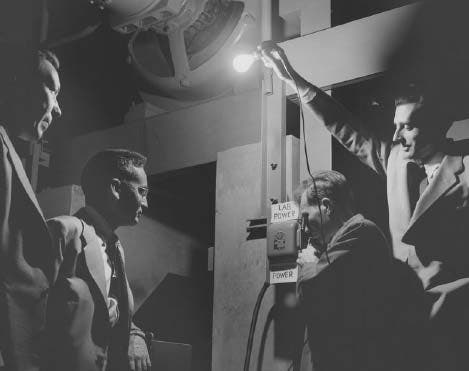Organizing the Effort
1940-1942
The work of physicists begins to focus on the essential components for building an atom bomb. The U.S. government brings organizational structure and financial support to the undertaking.
January 1941
Glenn Seaborg, a physicist at the University of California, Berkeley, along with chemist Joseph Kennedy and graduate student Arthur Wahl, discovered element 94 that Seaborg named “plutonium” after the planet. The scientists discovered the new element by bombarding uranium with deuterons, the nuclei of the hydrogen isotope deuterium. Seaborg submitted a paper to Physical Review announcing this discovery, but because of an agreement not to publish research results during the war, the journal did not publish the paper until 1946.
December 6, 1941
President Franklin D. Roosevelt authorized the Manhattan Engineering District (later called the Manhattan Project) with a $2 billion appropriation to build an atomic bomb. The next day planes from the Japanese naval planes bombed U.S. military installations at Pearl Harbor, Hawaii, followed hours later by attacks on Midway and Wake islands, Guam, Hong Kong, Malaysia, Thailand, the Philippines, and Shanghai, China.
September 1942
Secretary of War Henry Stimson promoted Colonel Leslie Groves, an army engineer, to Brigadier-General and placed him in charge of the Manhattan Project. Groves recruited J. Robert Oppenheimer, a theoretical physicist working at Ernest Lawrence’s Radiation Laboratory in Berkeley, California, as the project’s scientific director.
November 1942
The Army Corps of Engineers began construction at the Clinton Engineer Works in Oak Ridge, Tennessee, for an uranium isotope separation plant. The Y-12 Plant, one of three enrichment facilities at Oak Ridge, utilized calutrons to separate electromagnetically uranium isotopes in order to produce weapons-grade material for the Manhattan Project.
December 1942
Enrico Fermi, head of the University of Chicago’s Metallurgy Laboratory, and colleagues produced the world’s first self-sustained nuclear chain reaction in a reactor named Chicago Pile-1. Fermi conducted the test under the west stands of the university’s 50,000 seat football stadium. Using a coded message Arthur Compton telephoned James Conant with news of the event: “the Italian navigator has reached the New World.”

